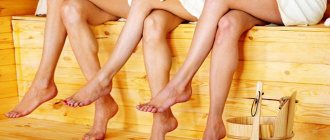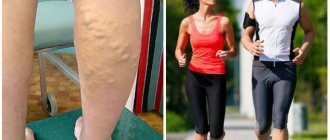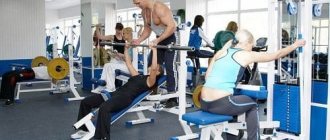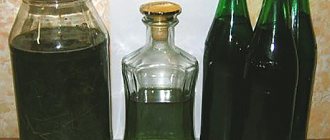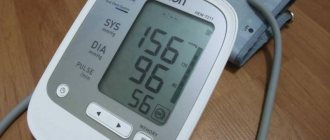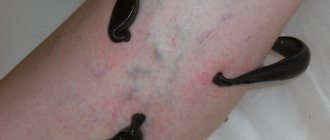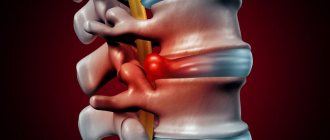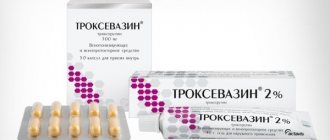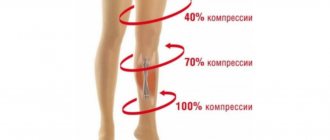What it is
When answering the question of what an elastic bandage is, it is worth noting its main difference from a regular medical one - increased extensibility and strength. With its help, you can securely attach various bandages, treat varicose veins, and fix joints during sprains and dislocations. It prevents the development of embolism, blockage of a vessel by an air bubble or blood clot.
The fixation agent is recommended for use when:
- thrombophlebitis;
- dislocations, ligament ruptures;
- after operation;
- vein diseases and indications for compression therapy.
A compression bandage for varicose veins is also a device that is intended for compression of the lower extremities. They have varying degrees of stretchability.
In case of vein dysfunction, the use of short distensibility devices is recommended. They should be 2.5-3 meters long and 8-10 centimeters wide. They should only stretch in length.
Contraindications
Despite the safety of the product, there are some contraindications that must be observed. An elastic bandage cannot be used in the following cases:
- advanced varicose veins;
- trophic ulcers with the release of serous or purulent exudate;
- vascular insufficiency;
- skin damage in the area where the bandage is applied;
- unhealed wounds after surgery.
Allergic reactions are also a contraindication to wearing a compression product. So, if you are allergic to natural wool, it is better to choose a bandage with a woven or non-woven base.
We invite you to familiarize yourself with Ointment for deep vein varicose veins
Compound
It consists of latex, cotton and polyester fibers. It is latex threads that give the product stretchability. This allows you to create uneven pressure on different parts of the body. This is why it is an excellent compression therapy.
The cotton content provides softness, prevents chafing and absorbs sweat. Polyester fiber makes the product durable and wear-resistant.
Thanks to these properties, the compression product can be washed several times. Also, polyester threads help securely fix joints and bandages.
Kinds
These medical devices are divided into two main types:
- Fabric. Their length can be adjusted, and they do not lose their properties after a large number of washes. Their service life is 6 months.
- Knitted. They are not so durable and crumble when cut.
To prevent the disease, you can use a high degree of extensibility, but if the veins are very dilated, then it is better to take a medium or short one.
They are also divided into:
- Lauma. They stretch well. Suitable for inflammation of the veins. The kit includes metal clamps. They help fix the product on the leg. Mainly used for sports injuries and after operations.
- Intex. It has little stretch and a flexible clasp. Their size is no more than 30 centimeters. It is hypoallergenic and does not cause skin irritation.
- Compression. Their lower limbs are tightened to restore proper blood flow. It fixes perfectly, creates the necessary pressure, and is easily removed. It can be used several times.
When do you need an elastic bandage for varicose veins?
Compression is the main type of treatment for varicose veins of the legs, for which the use of compression stockings (knee socks) is most effective. But there are cases when, due to an allergy to synthetic materials or difficulties in putting stockings on varicose legs with trophic ulcers, elastic bandages are used, which, provided the products are used correctly, also makes it possible to fix the veins in a compressed state, preventing the progression of varicose veins and stopping venous stagnation. As a result, the pastiness of the lower leg decreases and pain disappears.
It should be emphasized that the fixation of varicose veins with a bandage is elastic, which does not interfere with the patient’s movement, but at the same time it is dense, significantly larger than that of compression hosiery. In addition, the bandage makes it possible to regulate the tension force when fixing the veins, which makes it comfortable for any skin. But applying a bandage correctly can be more difficult than putting on a stocking, so both compression methods compete with each other on equal terms.
Terms of use
To get the maximum benefit, you need to know how to wear a bandage for varicose veins. If it is placed incorrectly on the leg, the effect will be far from therapeutic.
- It is necessary to bandage in the morning after waking up.
- Before putting on an elastic bandage for varicose veins, you need to lift the limb up. This will drain the blood and reduce swelling.
- You need to start from the foot, in weight. The higher it is wound, the less its pressure should be.
- It should be wound in layers. Each layer should overlap the other, while overlapping approximately 40%. There is no need to bandage above the knee. It is also recommended to carefully bandage the kneecap. If you press it, you will experience discomfort when walking. There is no need to bandage the heel.
- The compress should be worn throughout the day, taking a break at night.
- The medical product must be washed periodically. It is not squeezed out, but dried on a towel in a straightened form.
It is worth noting that even with proper dressing, fingers may turn blue. This is especially obvious when sitting. There is no blue tint when walking.
After surgery to remove the affected veins, your legs should be bandaged every time you need to get out of bed.
So they are bandaged for a month. Afterwards, you can switch to wearing compression stockings or tights. It is also important to remember that both limbs must be fixed at this time.
How to bandage
It is advisable that a doctor do this the first time. This will help you see the features of the dressing. If this is not possible, you should adhere to the rules.
- The bandage is placed on top of the foot. The thumb is located in this place, and the rest hold the leg on the other side. This will help create the desired tension.
- You should not wrap it further than the protruding bone; your fingers should be left free.
- Next, the rewind moves to the ankle. The heel remains free. The bandage is wrapped around the knee. Secure with adhesive tape.
Incorrectly applied fixation is indicated by loss of sensation in the fingers after 10 minutes, a feeling of tightness, pain, and pulsation. In this case, the bandage must be rewound.
Common mistakes
Figure 13. Error 1. Incorrect bandaging of the lower leg. The result is low pressure in the foot. Correct bandaging is a figure eight bandage going down to the foot and back.
Figure 14. Error 2. The space between the turns is too small. The middle of the calf muscle is reached, not the area below the knee
Figure 15. Error 3. The distance between the turns is too large to reach the popliteal area.
Figure 16. Error 4. Uneven application of the bandage to the limb, resulting in incorrect compression.
Figure 17. Error 5. Using an old, frayed, unusable bandage
Figure 18. Error 6. Incorrectly securing the bandage at the top. Using pins instead of adhesive tape.
- Wrong time for bandaging: Bandaging should be done in the morning before getting out of bed after a night's rest with your legs slightly elevated. And not after a shower, shaving or combing, breakfast or lunch. The morning shower should be replaced with an evening shower, before going to bed.
- Incorrect pressure: Figure 19 shows incorrect pressure on the leg, which will be useless since it is the same everywhere.
Figure 19. Error 7. Pressure is not distributed correctly. No beneficial effect. Bandaging is pointless.
Figure 20. Error 8. Pressure is not distributed correctly. It should go down from bottom to top, not from top to bottom.
Rules of care
The rubber present in the product makes it stronger and more durable. But it cannot withstand high temperatures. Therefore, they cannot be washed in hot water or ironed. Also, do not use alkaline detergents or boil the item during washing.
You can wash it in two ways: manually and using a washing machine. In the first case, you can use laundry soap or hand washing powder. The water should be warm and the powder will dissolve well. If it has large granules, they may not dissolve, but simply settle on the fabric.
If you decide to use a washing machine, you should select the “hand wash mode”. The temperature should not exceed 30°C. This is the optimal temperature for washing therapeutic knitwear.
Medical devices must not be squeezed or twisted. It needs to be given time to drain, and then carefully straightened and placed on a terry towel. You cannot dry it on a heating radiator.
Advantages and disadvantages
The advantages include low cost and good results.
Its use relieves swelling, reduces the feeling of heaviness, and improves blood circulation in the legs. And the disadvantages of an elastic bandage include inconvenience when wearing shoes, possible intolerance to materials, and the fact that it takes a lot of time to apply. It is also hot in the summer and can slide down when walking. Beginners may bandage the limb incorrectly, which will further aggravate the condition.
To ensure that the compression device lasts as long as possible, it must be washed after each use. It is better to have two sets available per shift.
During storage they should be rolled into a tube. When a product is worn out, it should be replaced with a new one. Preferably from the same manufacturer that was used before.
Where to buy and how to choose
You can buy them at any pharmacy in the city.
The price varies, so everyone can afford the product.
Recently you can find comfortable, smooth models on sale. Microfiber is added to them. This allows you to fit your leg perfectly and have a special clasp.
It is worth considering that this product is selected individually. Therefore, before purchasing, it would be a good idea to consult a phlebologist. But in any case, you shouldn’t take too tight ones. They are more suitable for fixing sprains.
Varicose veins are a disease in which deformation of the walls of blood vessels occurs. A sedentary lifestyle and excess weight can provoke pathology. If no action is taken, vascular damage can lead to disability.
Why does this product help so well?
The product is a soft, dense strip of fabric that retains its shape - this is the main difference from gauze analogues. Elastic bandages are made from cotton, lycra, and synthetic fabrics.
A high percentage of cotton component ensures better skin breathing while wearing the bandages. The use of elastic products is extremely wide: treatment, preventive wearing for varicose veins, fixation after injuries, operations.
Another important feature: the products are reusable. The cost of an elastic bandage is tens of times higher than the price of ordinary gauze, but if the latter has to be thrown away after several hours or a maximum of a day of use, then a high-quality fixing bandage will last weeks, even months after a muscle strain. Such items do not imply sterility.
What is it needed for
The price of an elastic bandage depends on several factors - type, composition, size, percentage of natural fabric, length, level of extensibility. Although this is the most expensive of dressings, for many diseases the patient needs it.
The properties of compression bandages significantly improve treatment results and help prevent various diseases. The range of application of special medical accessories includes several main areas:
- Sports and traumatology. In this area, the use of plaster casts and normal compression bandages to prevent injuries is widespread. For fractures, bandages are a means of preventing swelling, so a tight bandage is often applied first, and only then a cast. In case of sprains, medium tension is used to fix the joints.
- Phlebology. To correct venous pressure, prevent stagnation of blood flow and the formation of abnormal capacity of the veins of the lower extremities, “motion bandages”, long bandages (in severe cases), and medium elasticity are also used.
- In the treatment of lymphedema, the load from the bandages is added to the massage procedures to prevent the recurrence of lymph congestion and swelling.
- For burns, operations, correction of blood circulation in tissues, an elastic bandage protects against the pathological formation of colloidal scars and improves healing.
Two important parameters are considered to be rest compression - that is, the compression that appears in the absence of physical activity and the level of pressure during movement. Low pressure provides greater mobility, these models are called “long pull”. Medium, short elongation limits the load on the limbs and limits motor actions.
How to use it correctly
Before purchasing an elastic accessory, you need to understand how to use it correctly. Products of different stretchability are used in certain cases.
You need to learn how to bandage your leg with an elastic bandage to maximize the effectiveness of self-bandaging at home. The same rule applies to the other injured limb.
In order to apply a bandage, you can follow an algorithm that is easy to remember:
- It is better to carry out the procedure in the morning, at rest.
- If we are talking about the lower limb, it should be kept elevated - to drain the blood and prevent swelling and additional expansion of the veins.
- The bandage is placed on the leg from bottom to top, starting from the ankle and ending with the area below the knee joint.
- Each top layer in the process of application is weaker than the previous one, the bottom one lies the densest.
- Final fixation is carried out using special fasteners.
- Wearing the product should not be accompanied by the appearance of bruises or other side effects.
